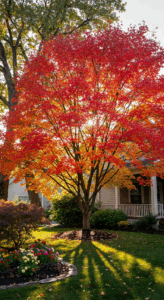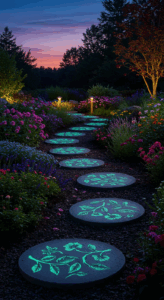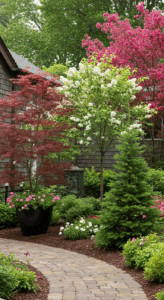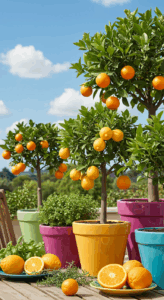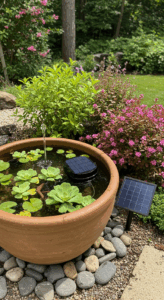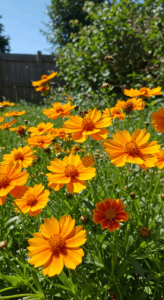1. Rustic Charm: Reclaimed Wood Raised Beds
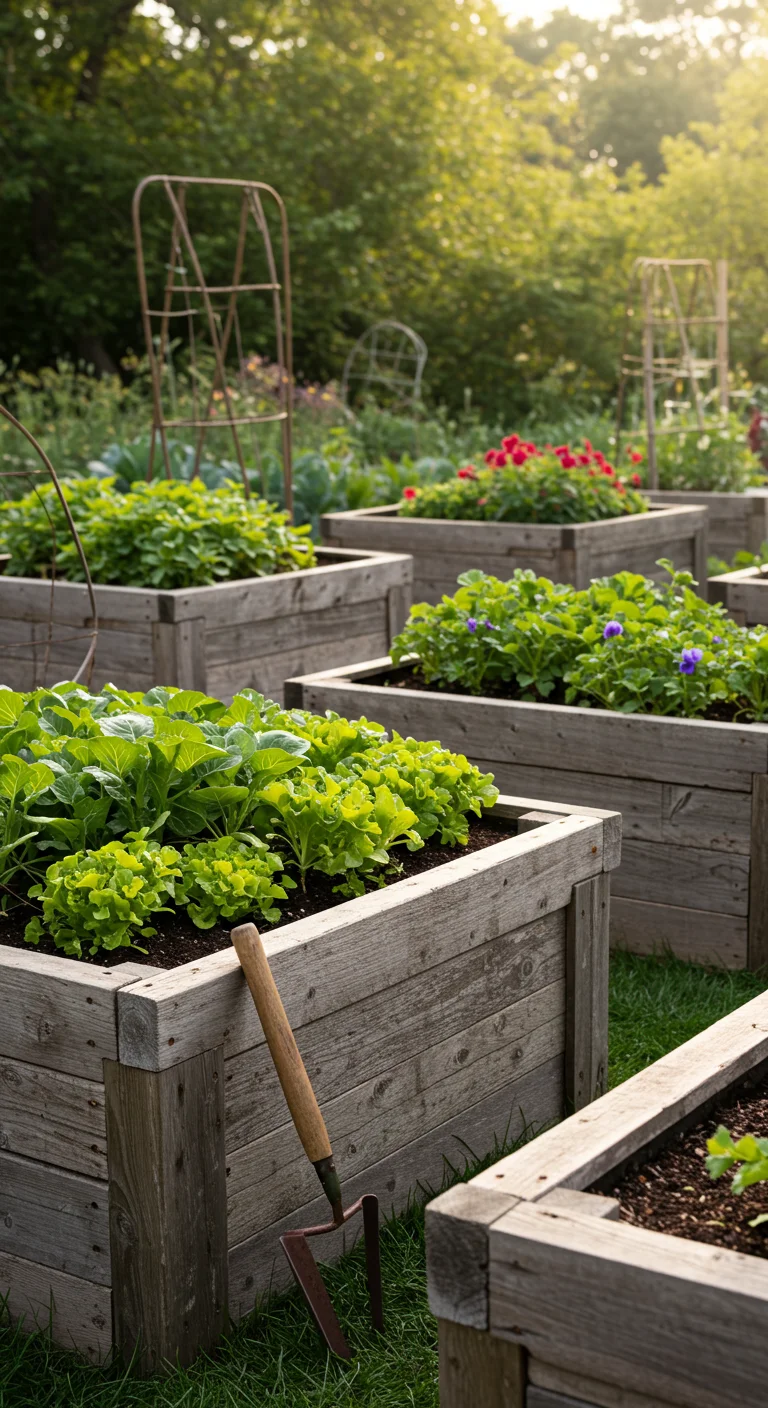
Rustic charm is beautifully embodied in reclaimed wood raised beds, which not only add aesthetic appeal to your garden but also promote sustainability. Using reclaimed wood sourced from old barns, pallets, or fences gives each raised bed a unique character and history. To construct these beds, ensure the wood is free from harmful chemicals and rot; a quick sanding and sealing can enhance their longevity. Create a layout that complements your garden’s design, perhaps incorporating varying heights for added visual interest. These beds are perfect for growing vegetables, herbs, and flowers, allowing for better soil drainage and easier access for maintenance. Additionally, the natural weathered look of the wood blends harmoniously with outdoor environments, creating an inviting space for gardening enthusiasts and nature lovers alike.
2. Modern Minimalism: Sleek Metal Raised Garden Boxes
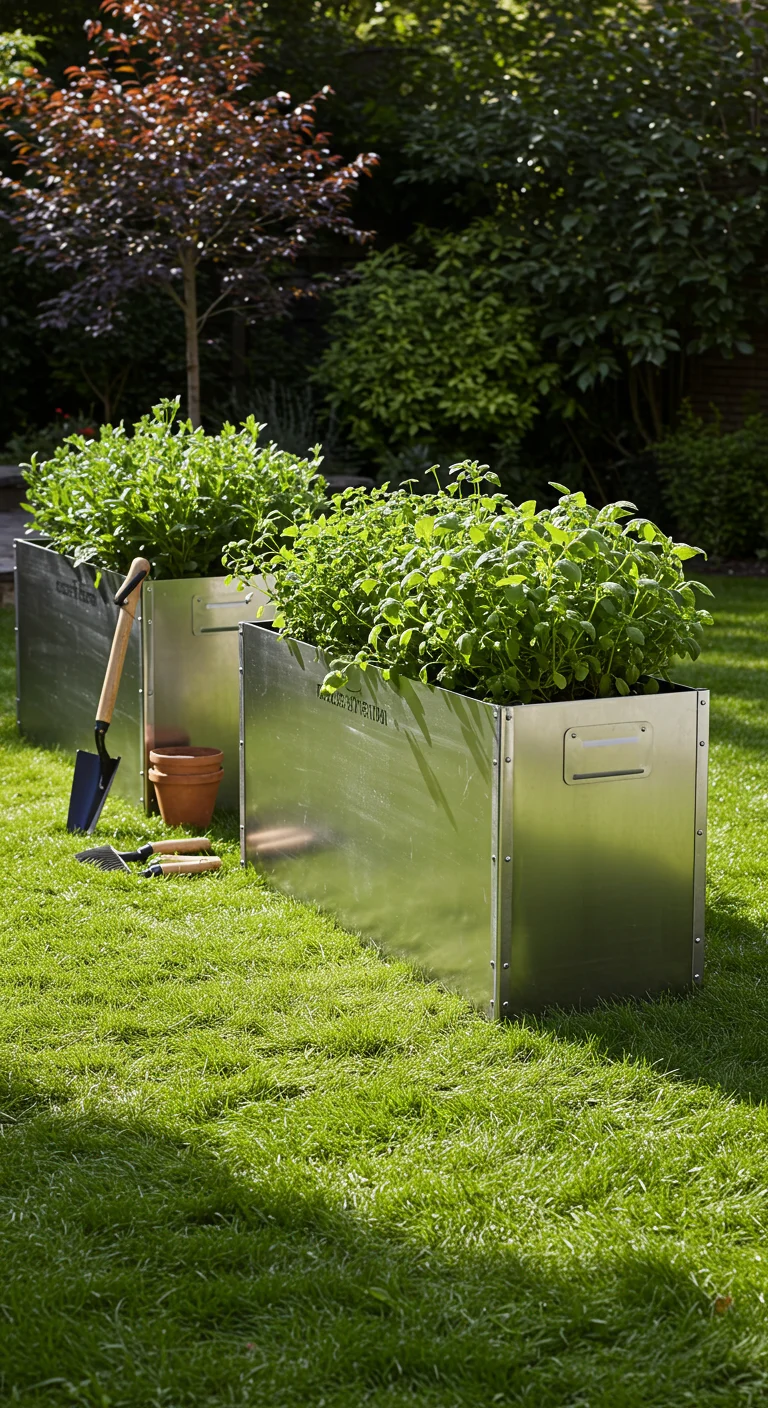
Modern minimalism in gardening embraces sleek designs and clean lines, making metal raised garden boxes a popular choice among contemporary gardeners. These boxes, often constructed from materials like corten steel or galvanized metal, offer durability and a striking aesthetic that complements any outdoor space. Their industrial look not only stands out but also provides excellent drainage and soil temperature regulation for your plants. Additionally, metal raised boxes can be easily assembled and customized in various sizes and heights, allowing gardeners to create a tailored gardening experience. The minimalist approach also encourages a focus on the plants themselves, making it ideal for those who appreciate simplicity and elegance in their outdoor aesthetics.
3. Space Savers: Vertical Raised Bed Gardens
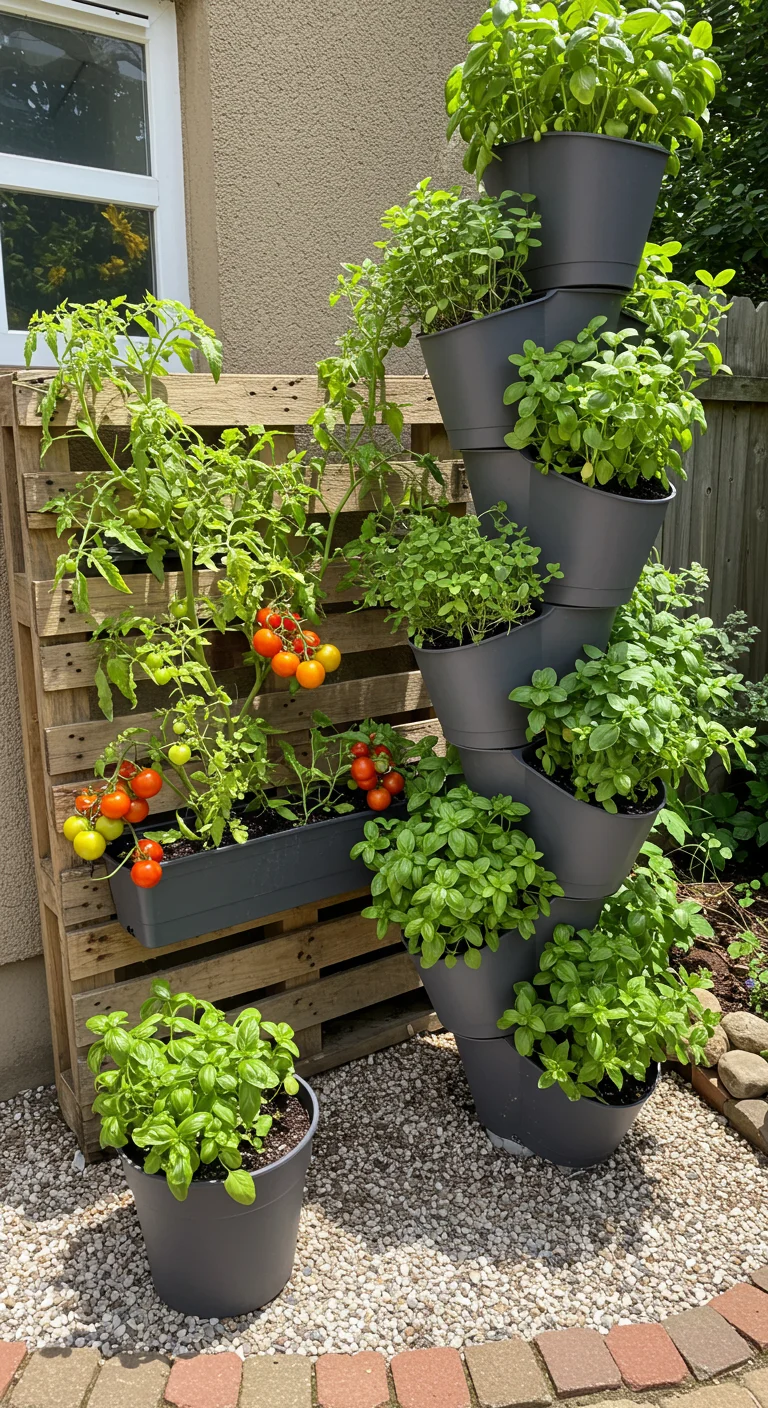
Vertical raised bed gardens are an innovative solution for maximizing space in small yards or urban environments. These gardens utilize vertical structures, such as wooden pallets, tiered planters, or wall-mounted systems, to create multiple planting levels, allowing you to grow a variety of vegetables, herbs, and flowers without taking up much ground space. By incorporating vertical elements, you not only increase your planting area but also enhance air circulation and sunlight exposure for your plants. Additionally, vertical gardens are easier to maintain, as they reduce the need for bending and kneeling, making gardening accessible for individuals of all ages and physical abilities. To start, consider using materials like repurposed wood, metal racks, or even hanging pots to create your own vertical raised bed garden and enjoy the beauty and bounty it brings to your home.
4. Elevated Edibles: Standing Raised Beds for Easy Access
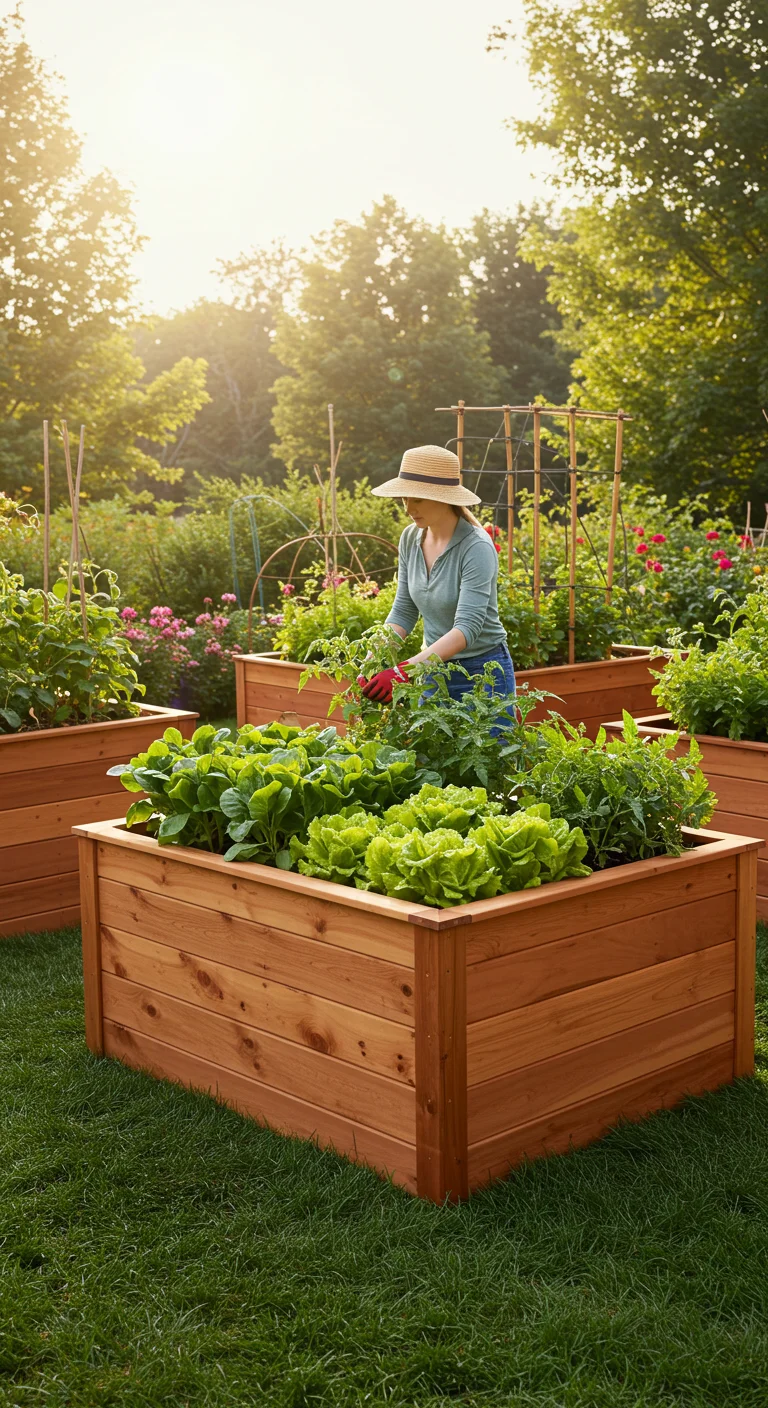
Elevated edibles, or standing raised beds, provide a fantastic solution for gardeners seeking ease of access while cultivating fresh vegetables and herbs. These raised beds, typically constructed from durable materials like cedar or composite lumber, are elevated to a comfortable height, reducing the strain on your back and knees during planting and harvesting. With dimensions often designed to fit standard wheelchair height, they are also accessible for individuals with mobility challenges. Incorporating a drip irrigation system can further enhance their efficiency, ensuring your plants receive consistent moisture. Not only do these elevated beds promote better air circulation and drainage, they also add an aesthetic appeal to your garden, making them a practical and beautiful addition to any outdoor space.
5. Curved Creativity: Circular Raised Bed Designs
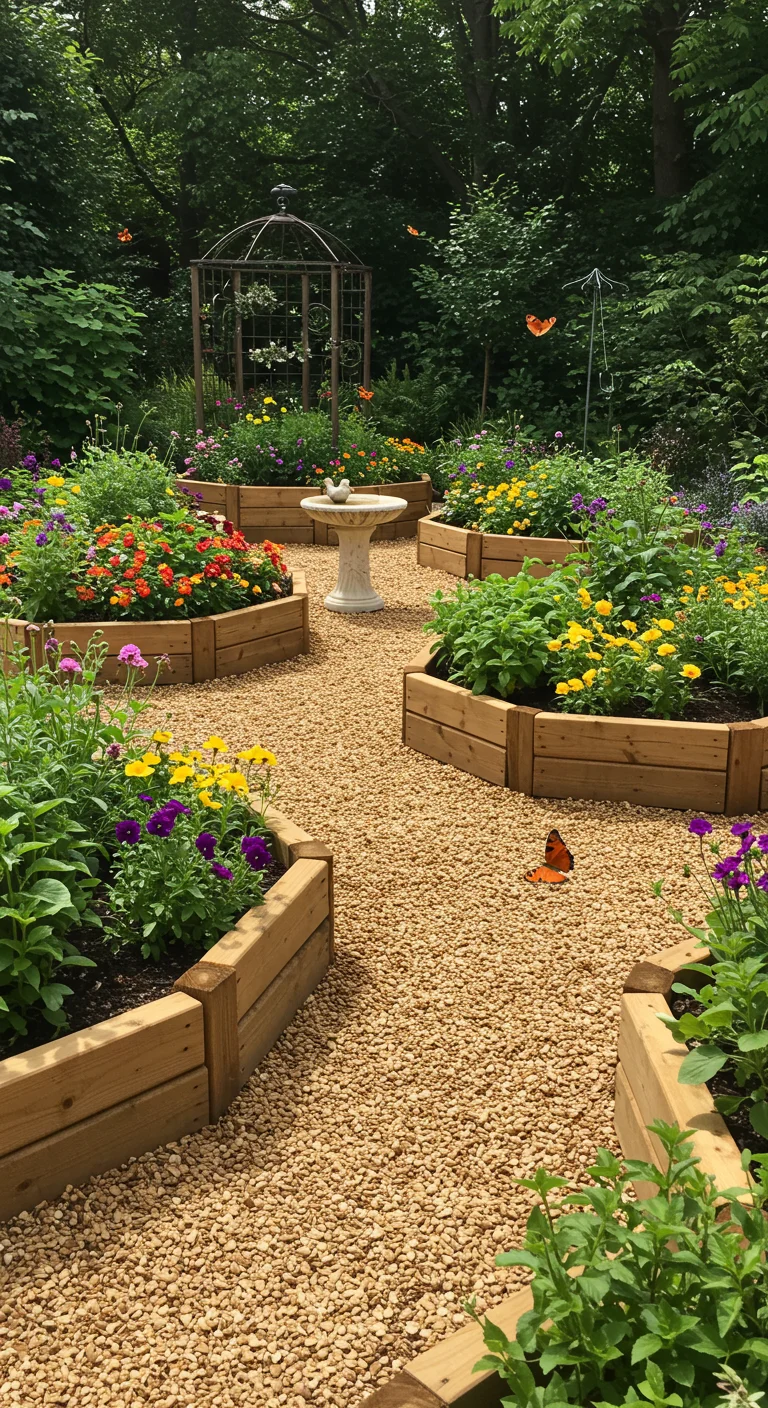
Curved creativity in garden design can transform a traditional raised bed into an eye-catching focal point. Circular raised bed designs not only maximize space but also create a more organic flow in your garden layout. These beds can be constructed using a variety of materials, such as wood, stone, or recycled materials, and can be customized in size to suit your gardening needs. To enhance accessibility, consider adding a central pathway or stepping stones, allowing easy access to plants regardless of their height. Incorporating flowers or herbs along the perimeter can add vibrant colors and fragrances, attracting beneficial insects while creating a stunning visual appeal. With a little planning and creativity, circular raised beds can elevate your gardening experience and aesthetics, making your space both functional and beautiful.
6. Kids’ Paradise: Fun and Functional Raised Beds
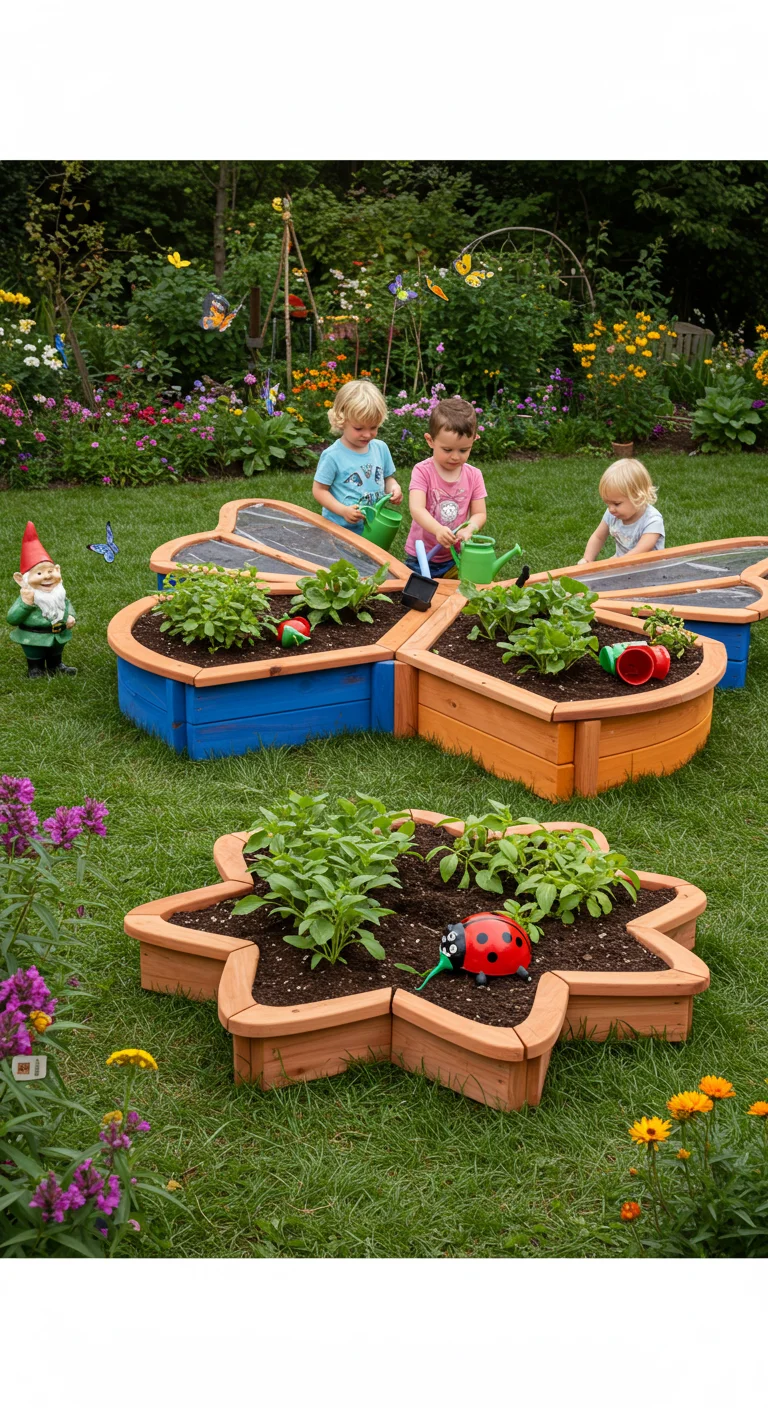
Creating a raised bed garden designed specifically for kids can transform gardening into a magical adventure. Choose colorful, child-sized beds that are accessible and easy to maintain, ensuring that little hands can plant, water, and harvest with joy. Incorporate fun elements such as whimsical shapes, painted designs, or even integrated seating to make the space inviting. Use lightweight materials like cedar or composite wood to ensure safety and durability. To engage children further, consider planting fast-growing vegetables, herbs, or flowers that attract butterflies and bees. This not only promotes responsibility but also nurtures a love for nature and healthy eating from a young age. With a little creativity, these raised beds can serve as a vibrant playground for learning and exploration, making gardening a delightful experience.
7. Herb Haven: Small Raised Beds for Culinary Herbs
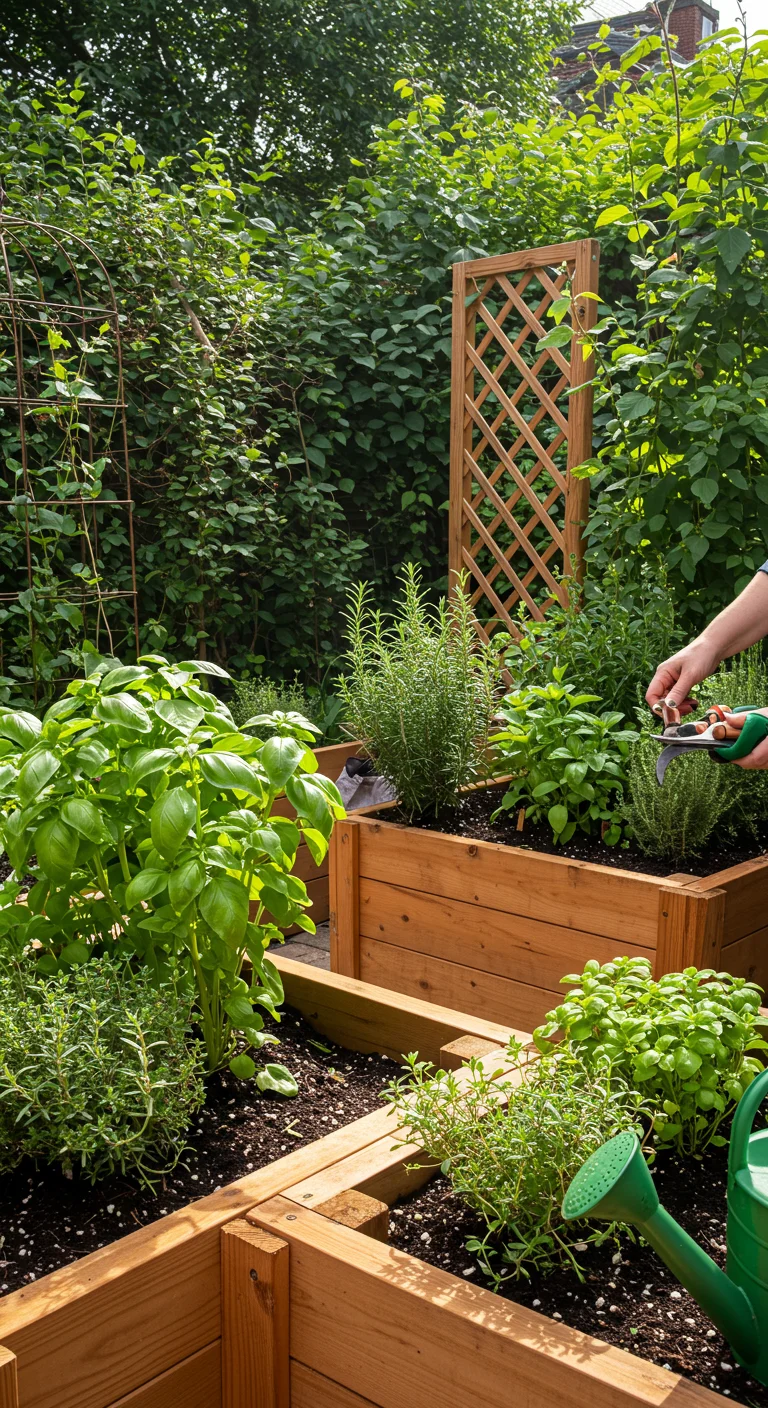
Creating a small herb haven with raised beds is an excellent way to cultivate fresh culinary herbs right in your backyard. These compact gardens can fit into limited spaces, such as patios or balconies, making them ideal for urban gardeners. Opt for a design that includes multiple shallow beds, each accommodating a variety of herbs like basil, rosemary, thyme, and parsley. Using untreated cedar or redwood not only ensures durability but also enhances drainage, which is crucial for herb growth. Incorporating a trellis or decorative fencing can provide additional support and aesthetics. Regularly harvesting your herbs not only encourages growth but also ensures a fresh supply for your culinary needs, making your small herb garden both functional and visually appealing.
8. Colorful Containers: Painted Raised Beds for a Pop of Color
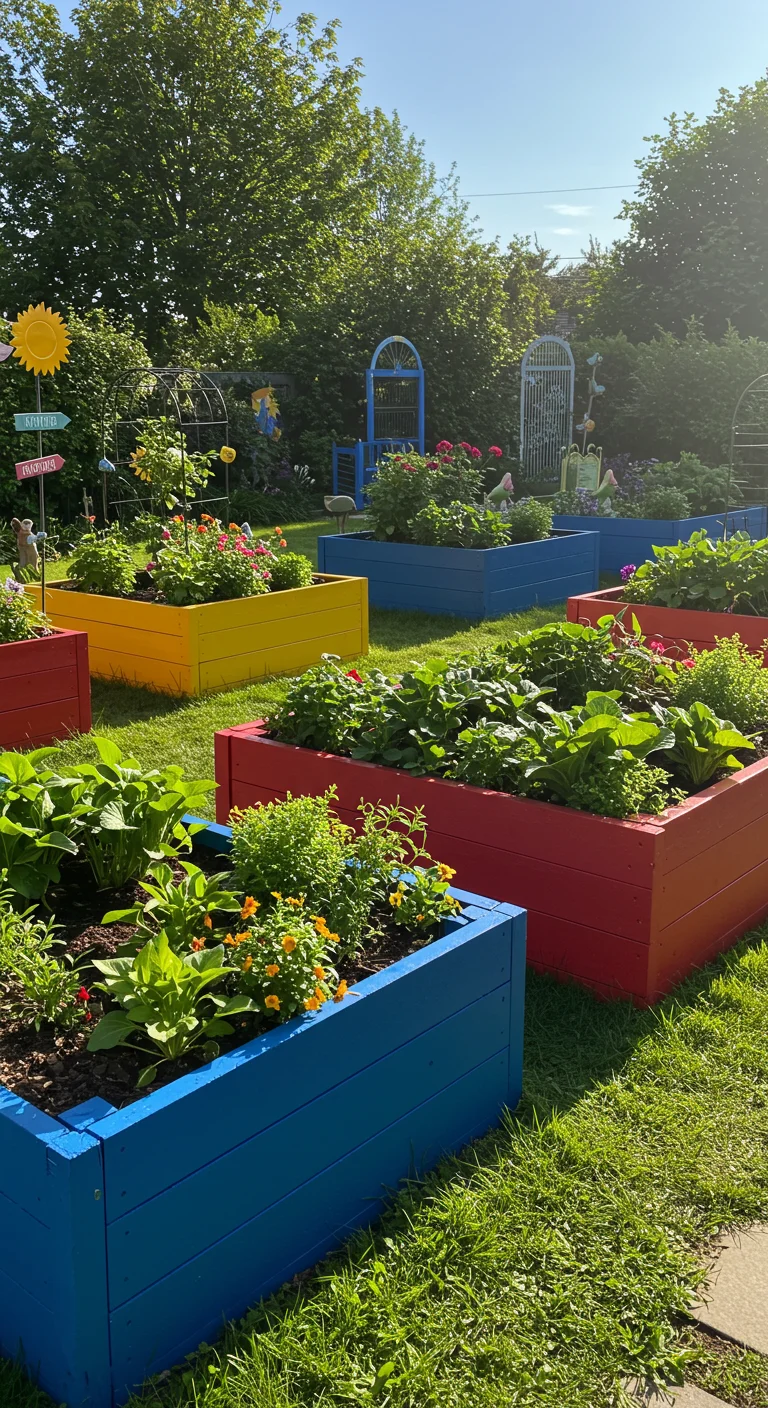
Transforming your garden with colorful containers can add vibrancy and personality to your outdoor space. Painted raised beds are an excellent way to incorporate a pop of color while also creating a functional garden. Use non-toxic, weather-resistant paint to ensure durability and safety for your plants. Consider choosing bright hues or playful patterns that complement your garden’s natural landscape; for instance, sunny yellows or deep blues can create a stunning contrast against green foliage. You can also use stencils or tape to create unique designs, such as stripes or polka dots. Additionally, consider painting the inside of your raised beds a lighter color to reflect sunlight, helping to keep soil temperatures regulated. These colorful containers not only enhance the aesthetic appeal of your garden but also inspire creativity and joy in your gardening journey.
9. Eco-Friendly Options: Pallet Raised Bed Gardens
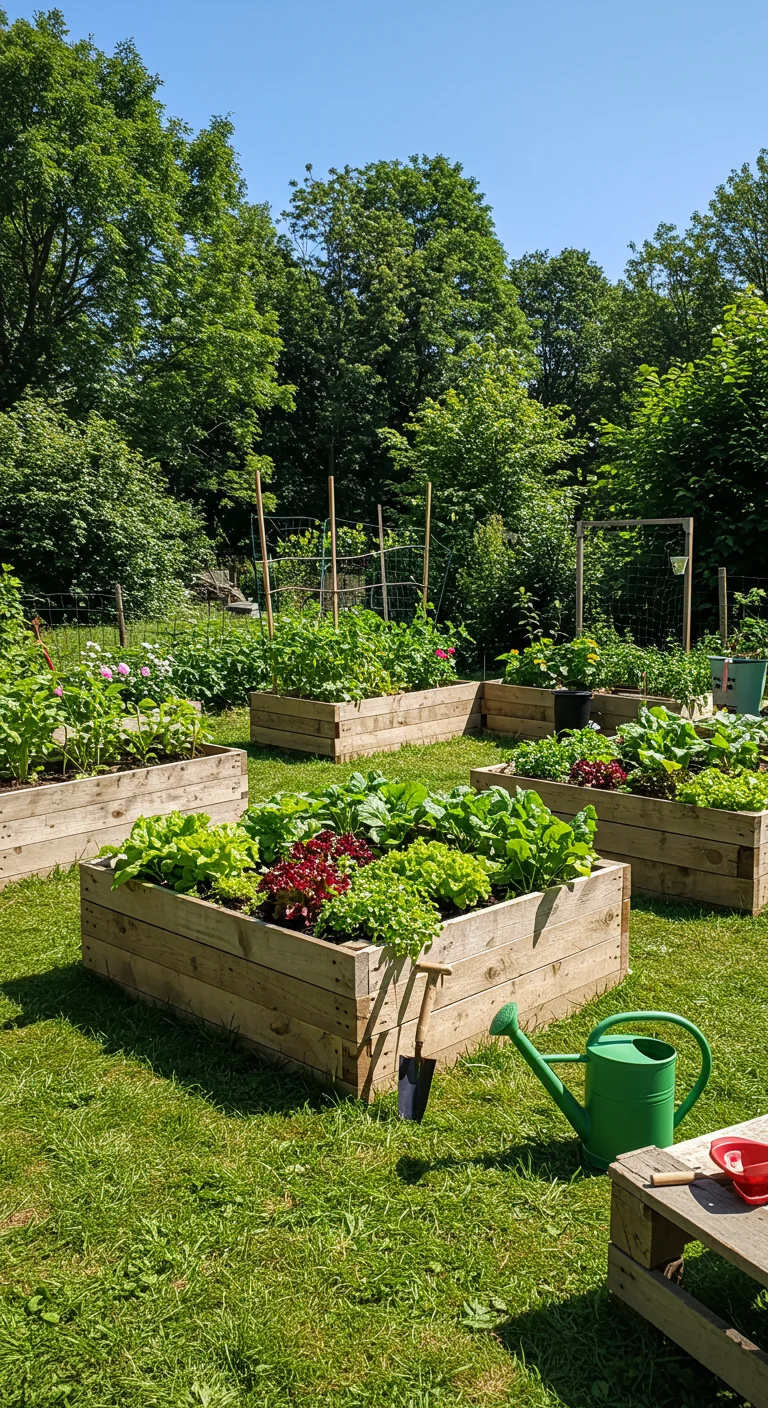
Pallet raised bed gardens are an excellent eco-friendly option for gardening enthusiasts looking to repurpose materials while minimizing waste. By using reclaimed wooden pallets, you can create sturdy and visually appealing raised beds that can be customized to fit your garden’s size and aesthetic. To ensure the safety of your plants, it’s important to choose heat-treated pallets, which are free of harmful chemicals. Simply disassemble the pallets, sand them down to remove any splinters, and then assemble them into the desired shape. Fill your new raised beds with nutrient-rich soil, and consider adding a layer of mulch to retain moisture and suppress weeds. This sustainable gardening method not only reduces your carbon footprint but also provides a unique and rustic charm to your outdoor space.
10. Natural Borders: Stone and Brick Raised Beds
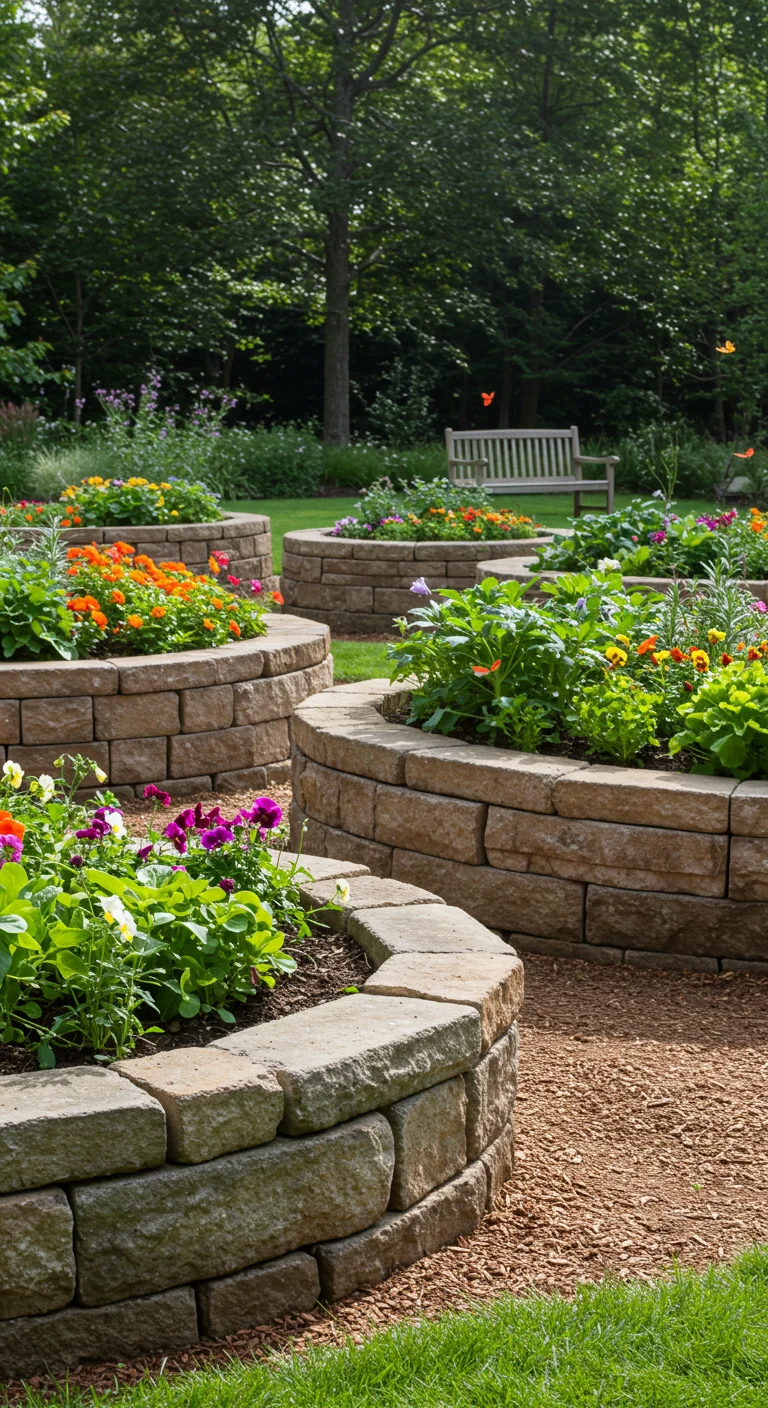
Natural borders made from stone and brick can create visually appealing and durable raised beds for your garden. These materials not only enhance the aesthetic of your outdoor space but also provide excellent drainage and insulation for plant roots. When constructing stone or brick raised beds, consider using a mix of larger stones for the base and smaller bricks or stones to add height and texture. Ensure that the edges are securely fitted to prevent soil erosion, and fill the beds with a nutrient-rich soil mix to promote healthy plant growth. Additionally, incorporating a variety of plant heights and colors will further enhance the natural beauty of your garden, making it a serene retreat for relaxation and enjoyment.
11. Garden on Wheels: Mobile Raised Bed Solutions
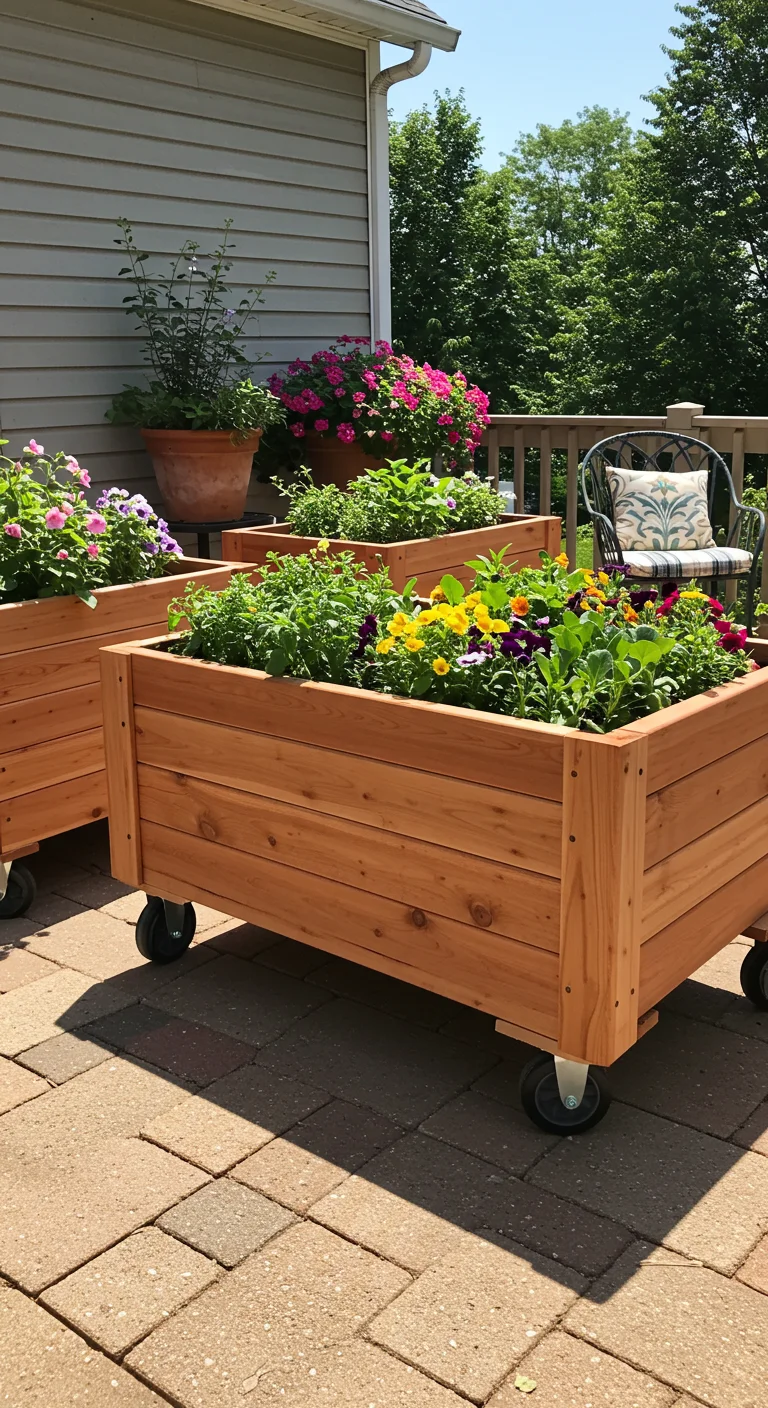
Mobile raised bed gardens, often referred to as ‘gardens on wheels,’ provide a flexible and innovative solution for those with limited space or changing environments. Constructed using lightweight materials such as cedar, metal, or composite wood, these mobile beds are typically mounted on sturdy wheels for easy maneuverability. They can be placed anywhere, making them ideal for sunny spots on patios, balconies, or even indoors near windows. To enhance mobility, consider designing them with a lower profile and a width that allows for easy access from both sides. By using a variety of soil types and compost, you can customize each mobile bed to suit specific plants, maximizing your gardening potential while keeping your space versatile and adaptable.
12. Tiered Triumph: Multi-Level Raised Garden Beds
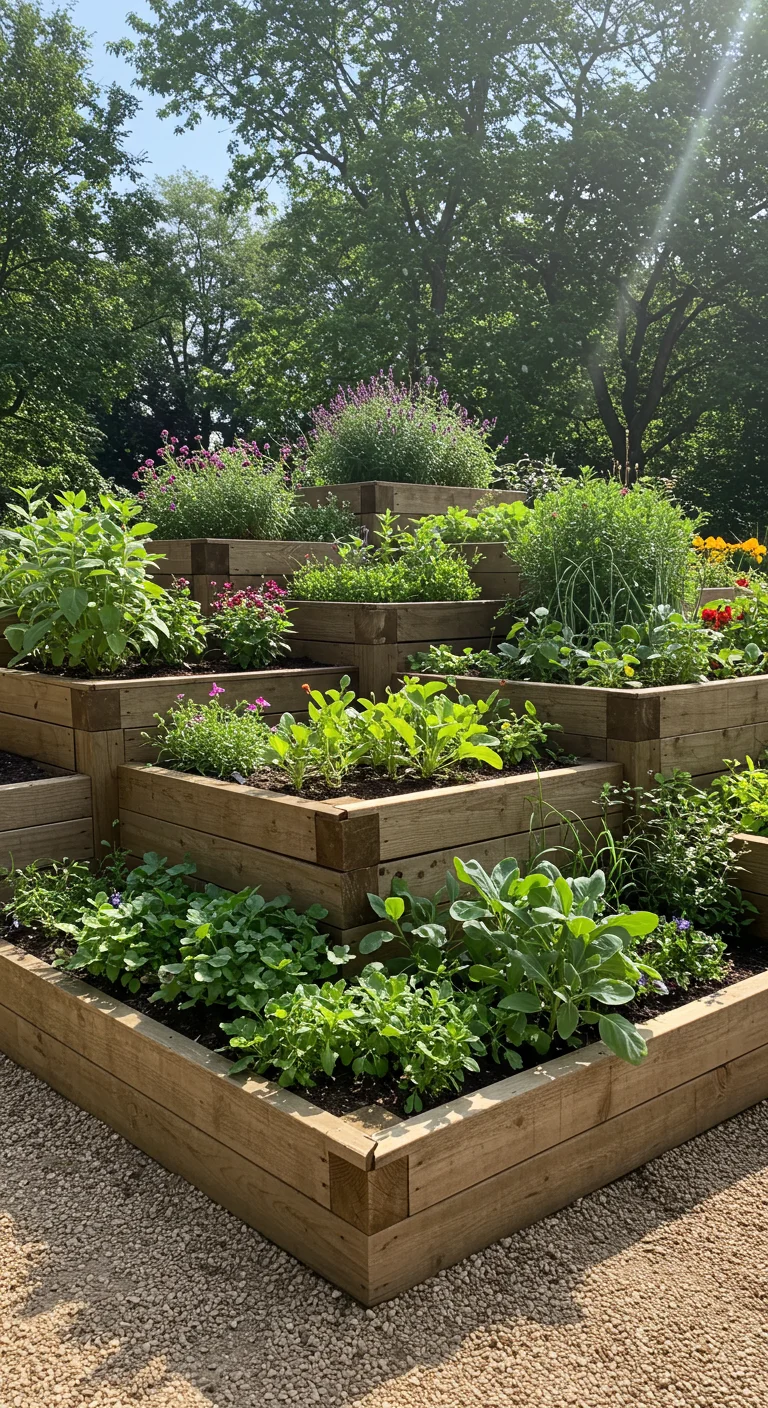
Tiered triumph is achieved through the construction of multi-level raised garden beds, which not only maximize space but also create an aesthetically pleasing landscape. These beds, often arranged in a cascading format, allow for better drainage and sunlight exposure, essential for healthy plant growth. Begin by selecting a sturdy material such as wood or stone, and consider the height of each tier to accommodate different plant types—herbs, vegetables, and flowers can all thrive at various elevations. Incorporating pathways between the tiers enhances accessibility and maintenance, ensuring that you can easily tend to your plants. This design not only provides an innovative gardening solution but also adds a dynamic and visually striking element to your backyard or garden area.
13. Garden Art: Sculptural Raised Bed Designs
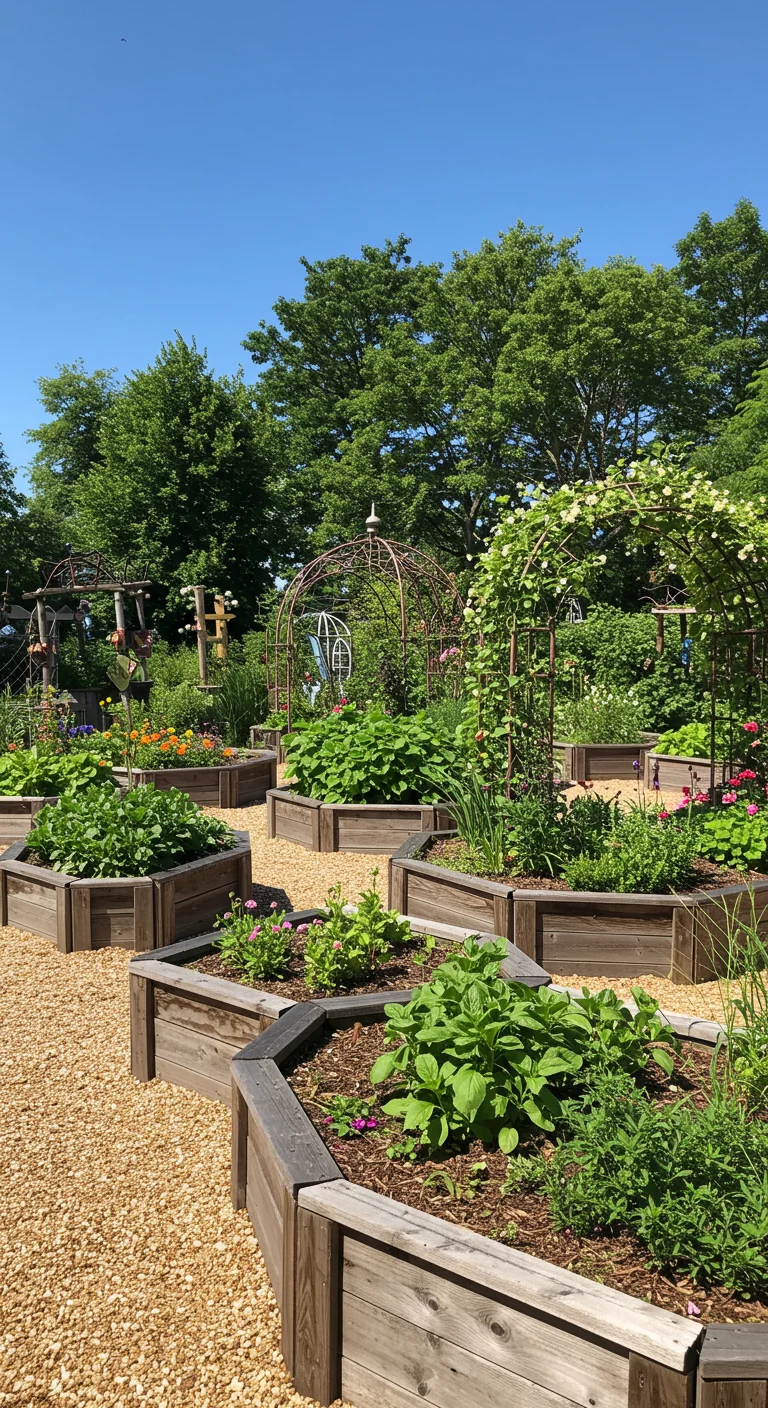
Sculptural raised bed designs blend functionality with artistic expression, transforming your garden into a vibrant outdoor gallery. These unique beds can be crafted from various materials, such as weathered wood, stone, or metal, and can take on forms that range from geometric shapes to whimsical creatures. Incorporating elements like trellises or vertical features not only maximizes space but also adds height and visual interest. Consider using brightly colored paints or finishes to enhance the aesthetic appeal, or opt for natural patinas that harmonize with your landscape. Ultimately, sculptural raised beds invite creativity and personalization, allowing you to cultivate both plants and a stunning visual environment in your garden.
14. Sustainable Solutions: Built-In Composting Raised Beds

Built-in composting raised beds offer an innovative and sustainable way to enrich your garden soil while managing kitchen and garden waste. These raised beds are designed with a composting system integrated into their structure, often featuring a compartment or chamber at the base where organic matter can decompose. As kitchen scraps, yard waste, and other biodegradable materials break down, they provide essential nutrients to the plants above, promoting healthier growth and reducing the need for chemical fertilizers. To create your own, choose rot-resistant materials like cedar or composite lumber, ensure proper drainage, and layer your compostable materials effectively. This method not only minimizes waste but also creates a thriving ecosystem that supports biodiversity in your garden, making it a rewarding project for eco-conscious gardeners.
15. Classic Appeal: Traditional Wooden Raised Beds
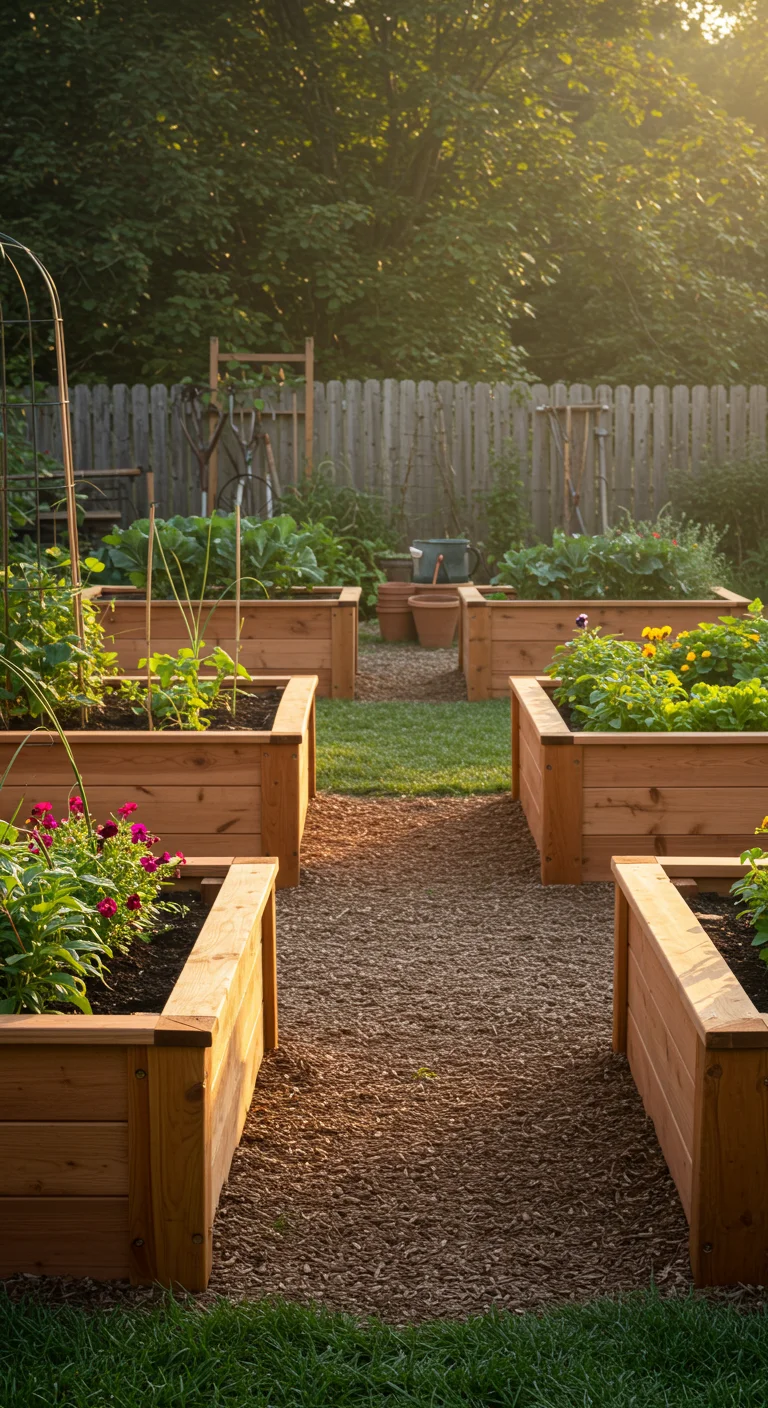
Classic wooden raised beds are a timeless choice for any gardener seeking durability and aesthetic appeal. Constructed from untreated cedar or redwood, these beds not only blend seamlessly with natural landscapes but also resist decay, ensuring longevity. Standard dimensions often range from 4×4 to 4×8 feet, allowing for easy access to plants while optimizing space for a variety of vegetables and flowers. To build, simply cut the wood to size, assemble with screws or brackets, and consider adding a layer of landscape fabric at the bottom to prevent weeds. Enhancing these beds with a protective wood stain can also extend their life while adding a polished look. With their rustic charm, traditional wooden raised beds create a beautiful focal point in your garden, offering both functionality and style.
16. DIY with a Twist: Upcycled Materials for Raised Beds
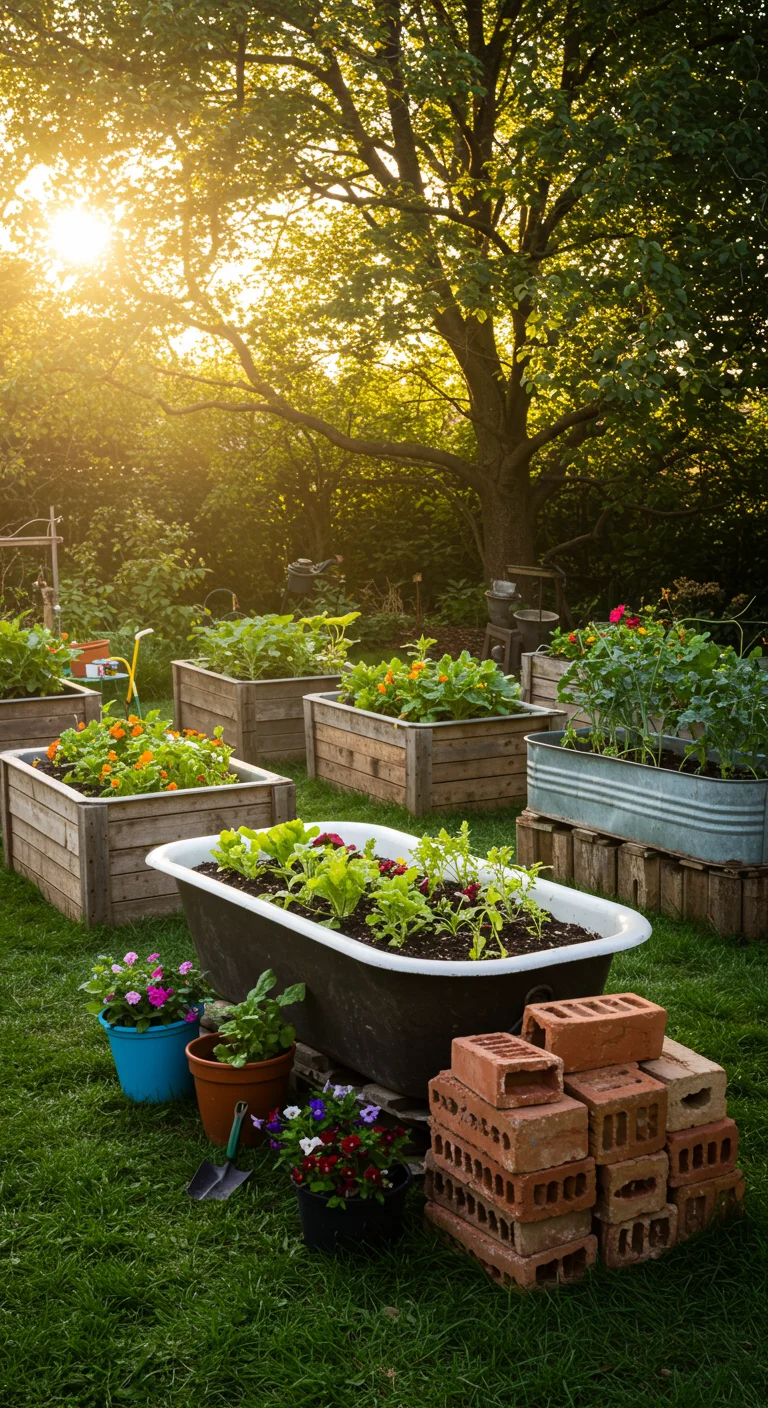
Upcycling materials for raised beds is a creative and sustainable approach to gardening that not only saves money but also reduces waste. Consider using old wooden pallets, which can be disassembled and reconfigured into stylish, rustic beds. Metal containers, such as old bathtubs or buckets, can add a unique aesthetic while being durable and capable of retaining heat for plants. Even discarded bricks or stones can be stacked to create charming, functional borders that promote better drainage. When choosing materials, ensure they are free from harmful chemicals, especially with treated woods. By personalizing your raised beds with upcycled materials, you contribute to a greener planet while showcasing your gardening style and ingenuity.
17. Wildlife Friendly: Raised Beds with Integrated Habitats
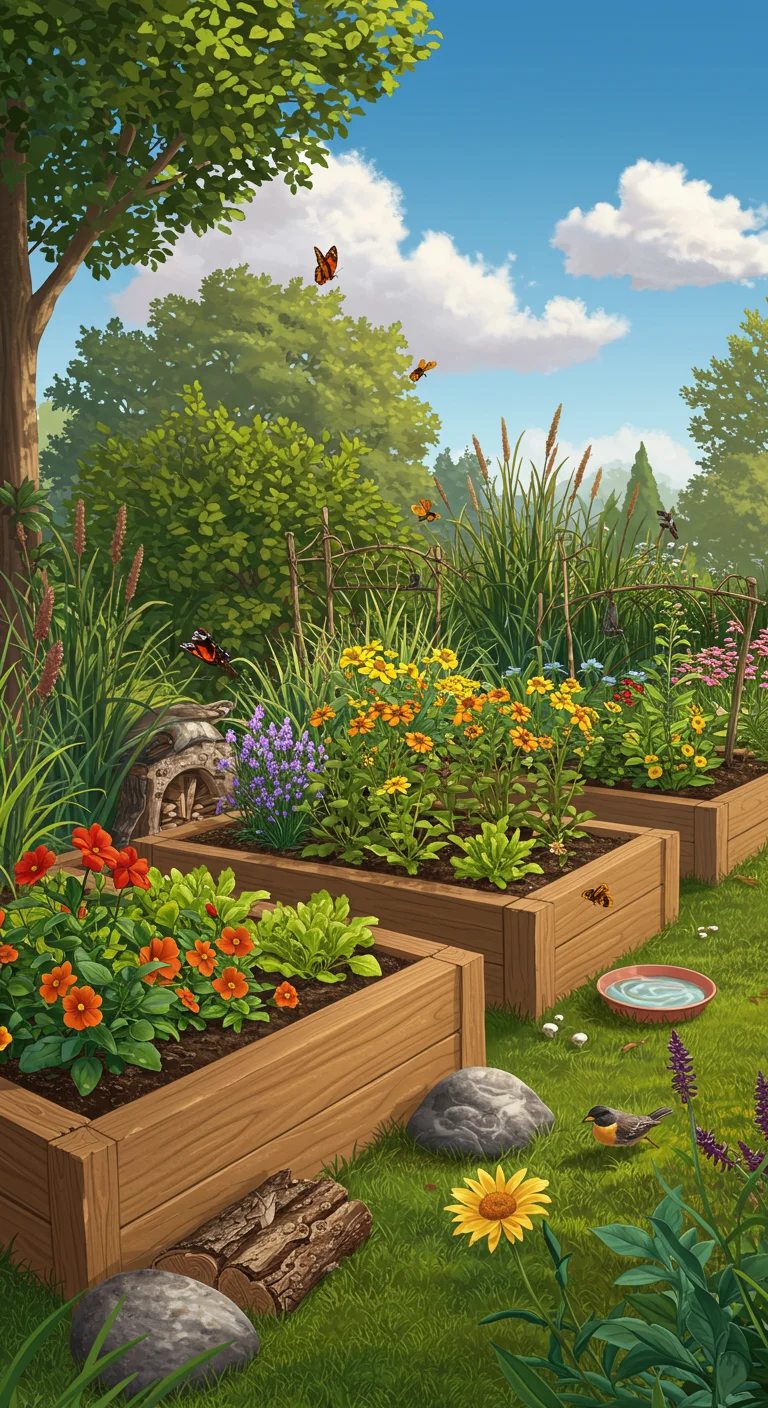
Wildlife Friendly: Raised Beds with Integrated Habitats are an innovative way to enhance biodiversity in your garden while cultivating vegetables or flowers. These raised beds can incorporate features such as small logs, rocks, or native plants that serve as habitat for beneficial insects, birds, and small mammals. By creating a diverse ecosystem, you not only attract pollinators like bees and butterflies but also help control pests naturally. Adding a water source, such as a small dish or fountain, can further encourage wildlife to visit. When designing these beds, consider using untreated wood and organic materials to ensure that your garden remains safe for all creatures. This harmonious coexistence can lead to healthier plants and a more vibrant garden environment.
18. Zen Gardens: Raised Beds for Tranquil Spaces
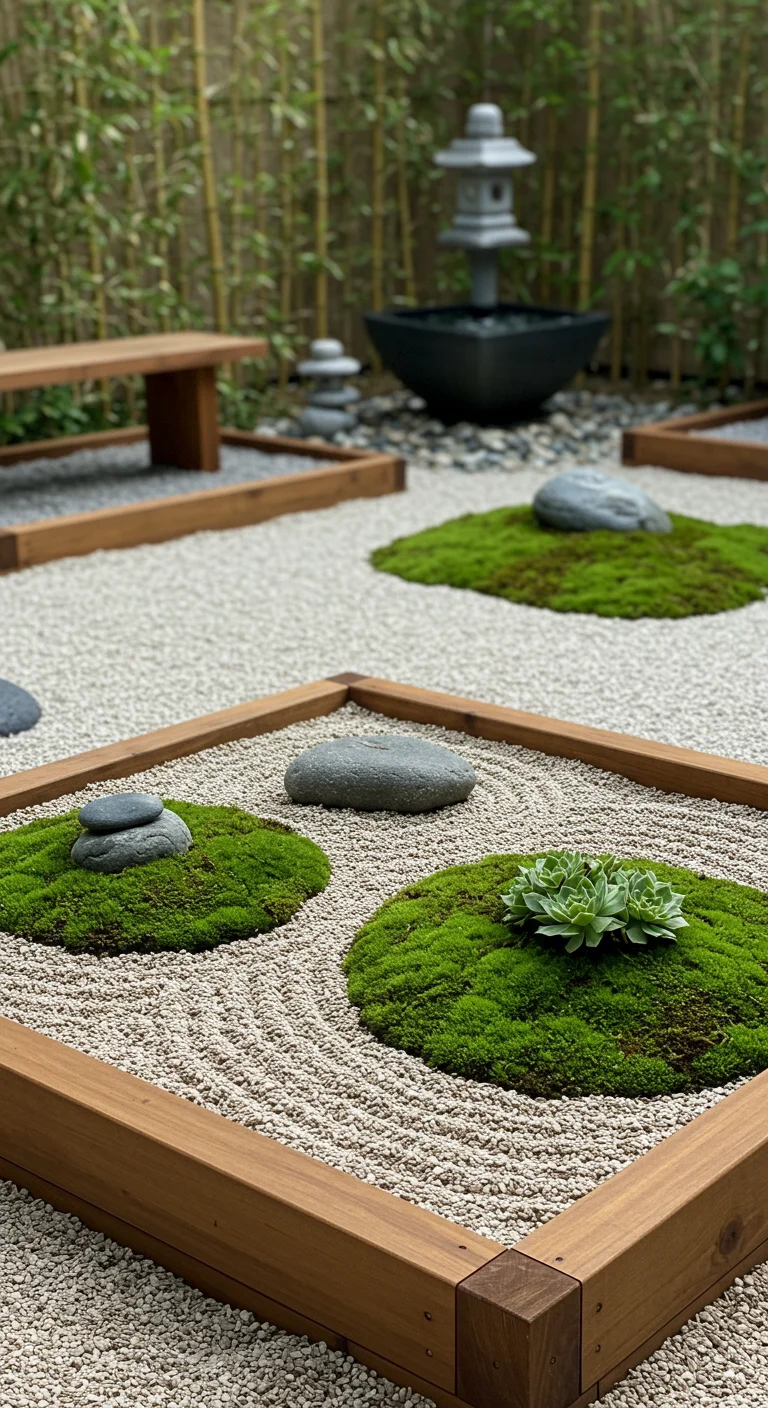
Zen gardens offer a serene and minimalist approach to gardening, perfect for creating tranquil spaces in your yard. By utilizing raised beds, you can design a low-maintenance, aesthetic garden that emphasizes natural elements like sand, gravel, and carefully selected stones. Start by framing your raised beds with untreated wood or stone to create distinct sections. Fill these beds with a mix of fine gravel for raking patterns and larger stones for focal points, while incorporating small plants like succulents or mosses that require minimal care. Enhance the calming atmosphere by adding a bench for meditation or a water feature, such as a small fountain, to invite serenity into your outdoor space. This DIY project not only beautifies your landscape but also provides a peaceful retreat from the hustle and bustle of daily life.
19. Community Spirit: Shared Raised Bed Gardens
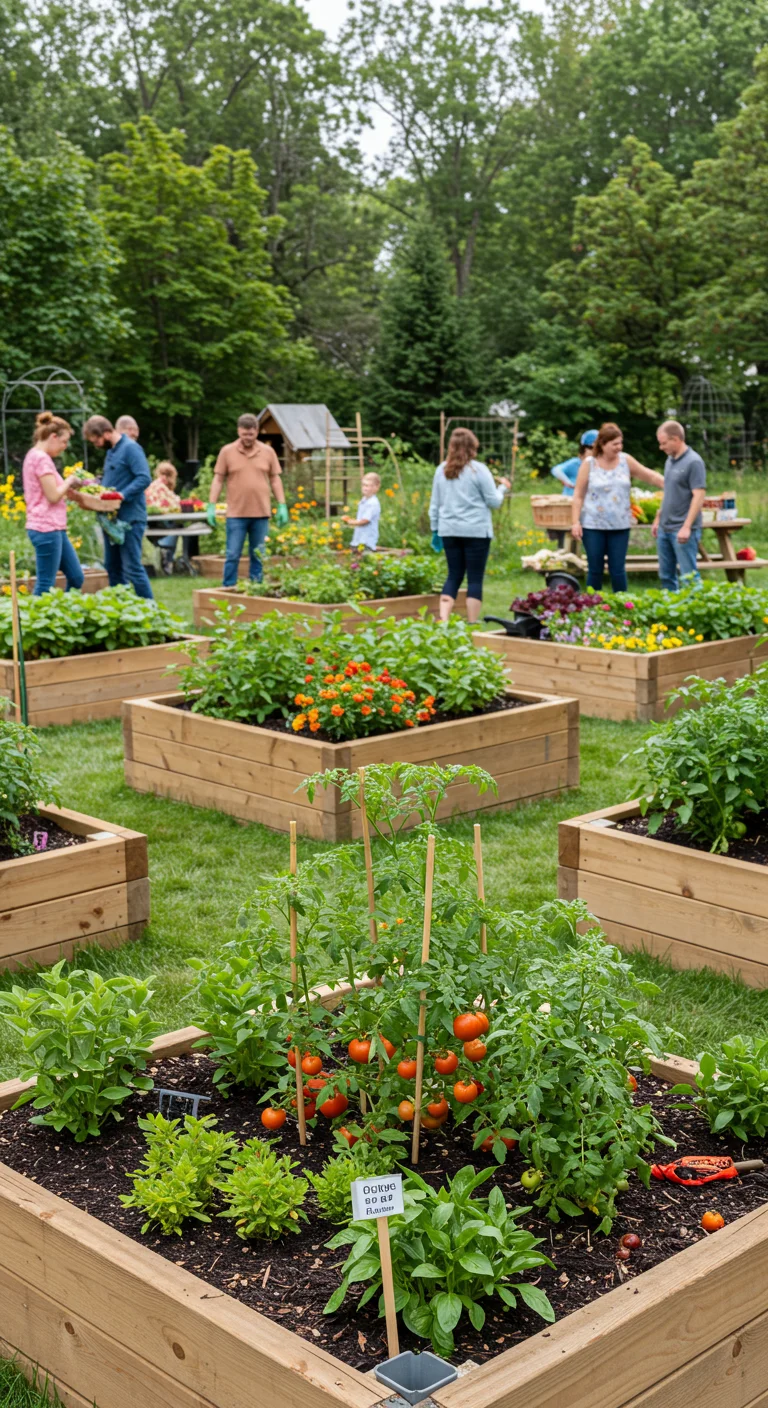
Community spirit thrives in shared raised bed gardens, where neighbors come together to cultivate not just vegetables, but also relationships. These communal gardening spaces allow individuals to pool resources, share knowledge, and enjoy the collective joy of gardening. To create a shared raised bed garden, start by designating a common area and gather input from participants on what crops to grow. Opt for raised beds built from durable materials like cedar or recycled metal to ensure longevity. Each member can have their own section, fostering a sense of ownership while promoting teamwork. Regular meetings can be held to share gardening tips, plan crop rotations, and even organize potluck dinners featuring the garden’s bounty, enriching both the soil and the community bonds.
20. Luxurious Layers: In-Ground Raised Bed Gardens
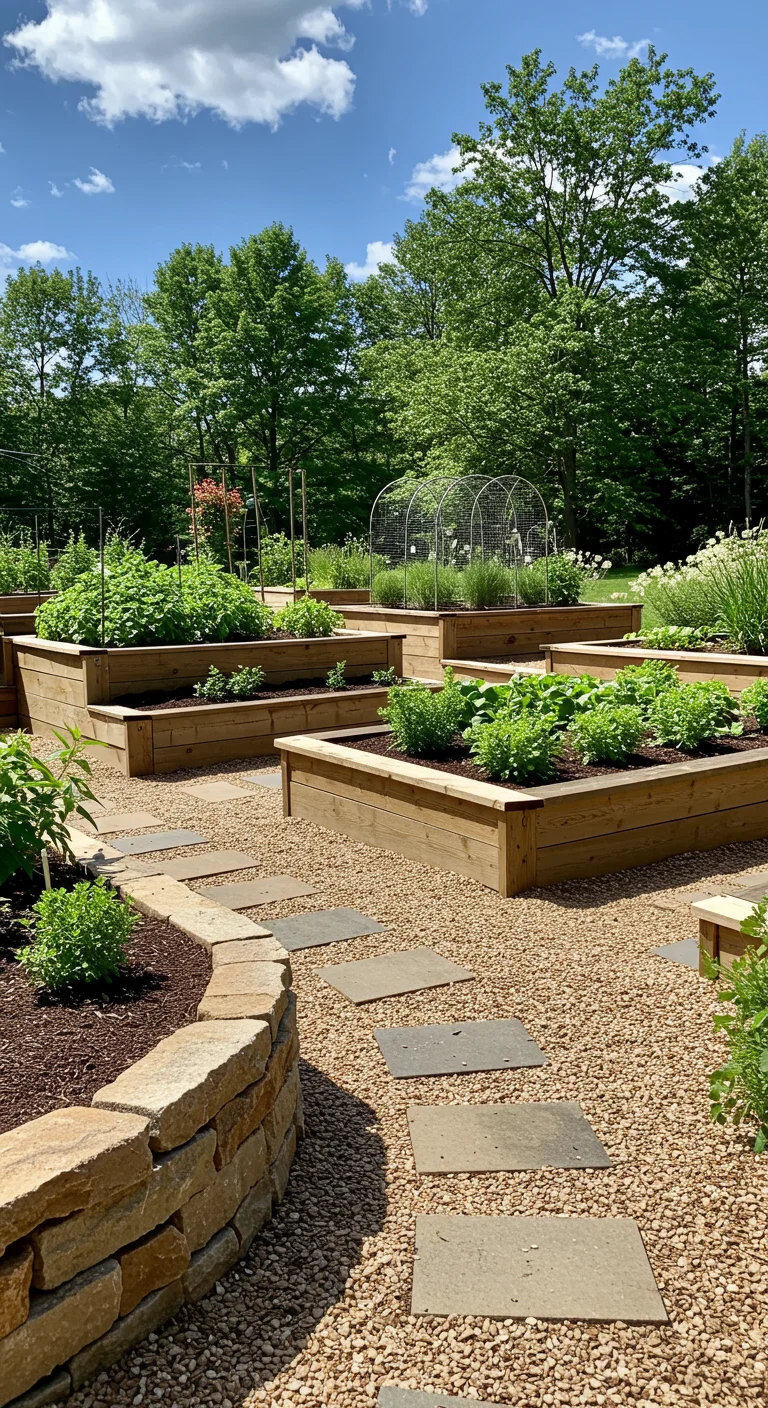
Luxurious layers in in-ground raised bed gardens offer a stunning and functional approach to gardening. By combining rich soil with various organic materials such as compost, mulch, and native plants, gardeners can create a multi-tiered system that promotes healthy growth and drainage. These beds can be designed to fit any landscape, whether nestled into a hillside or standing out in a flat yard. To enhance aesthetics, consider using natural stone, reclaimed wood, or decorative bricks as borders. Additionally, incorporating pathways between layers not only adds beauty but also makes maintenance easier. This method allows for controlled planting conditions and can accommodate a wide variety of herbs, vegetables, and flowers, ensuring a lush and vibrant garden space year-round.
21. Shade Seekers: Raised Beds for Shaded Areas
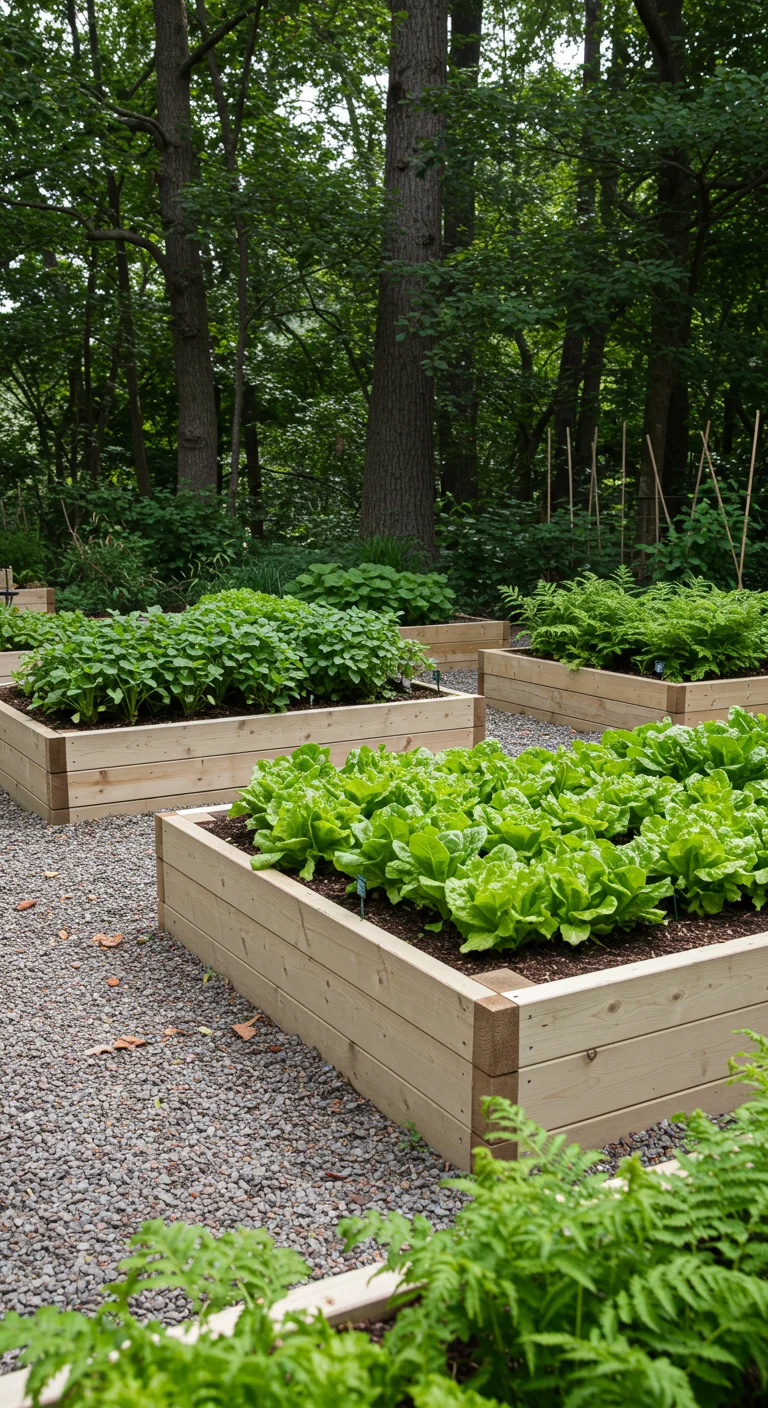
Shade seekers are perfect for gardeners working in areas that receive limited sunlight due to tall trees or nearby structures. Constructing raised beds in these shaded spots allows you to take advantage of the cooler microclimate while providing better drainage and soil quality. Choose shade-tolerant plants such as lettuce, spinach, ferns, or hostas, which thrive in lower light conditions. When designing your raised beds, consider using lighter-colored materials to reflect any available light and ensure proper airflow. To maximize growth, incorporate organic compost to enrich the soil and enhance its nutrient content. Remember that even in shaded areas, regular monitoring for pests is essential to maintain a healthy garden ecosystem.
22. Fencing Flair: Raised Beds with Integrated Fencing
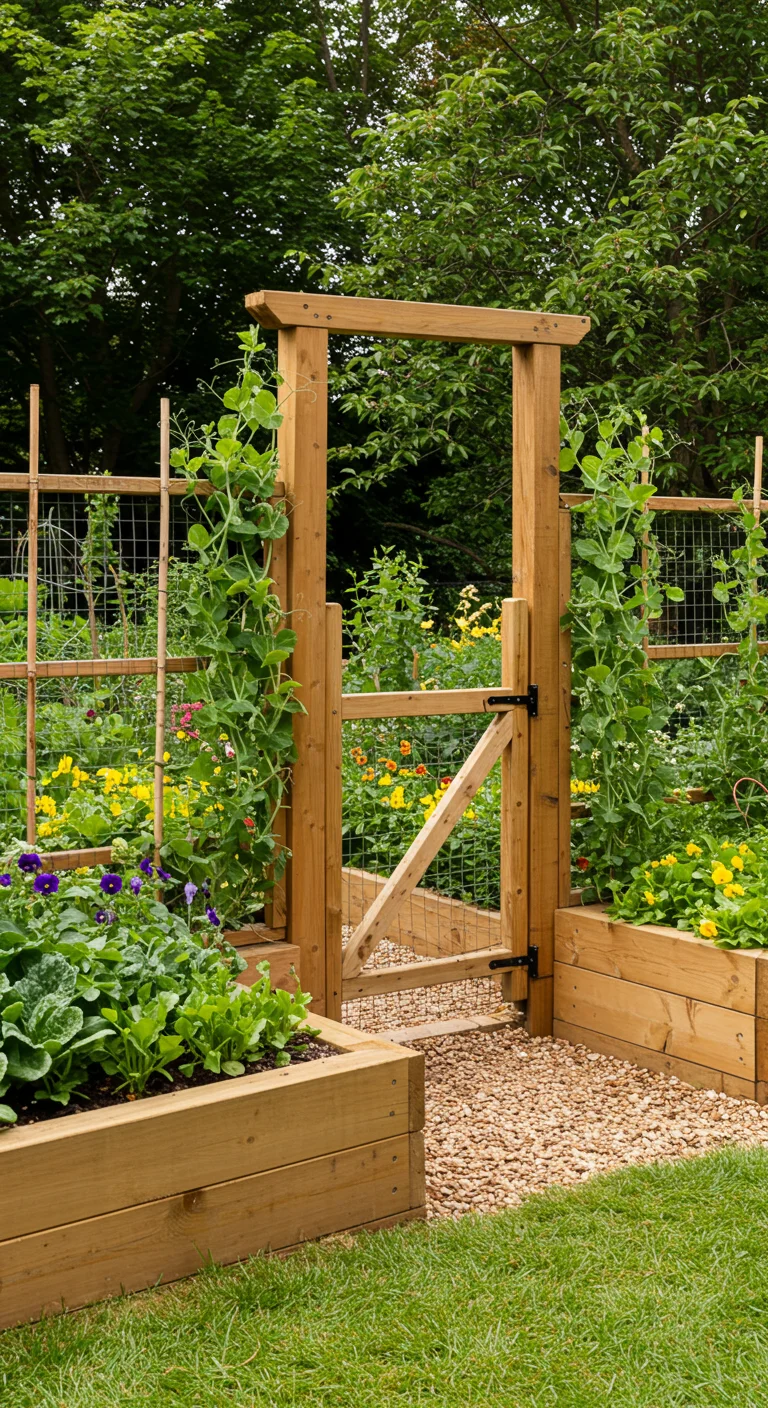
Fencing Flair: Raised Beds with Integrated Fencing combines beauty and functionality in your garden design. This innovative approach not only elevates your plants for better drainage and accessibility but also incorporates a stylish fence that protects your crops from pests like rabbits and deer. You can use materials such as cedar or treated wood for the beds, while the fencing can be made from chicken wire or decorative lattice panels, allowing sunlight to stream in while keeping critters out. Consider adding a gate for easy access and integrating climbing plants like peas or beans into the fencing to maximize your vertical space. This design not only enhances the aesthetics of your garden but also creates a cohesive and protective growing environment.
23. Artistic Edging: Decorative Borders for Raised Beds
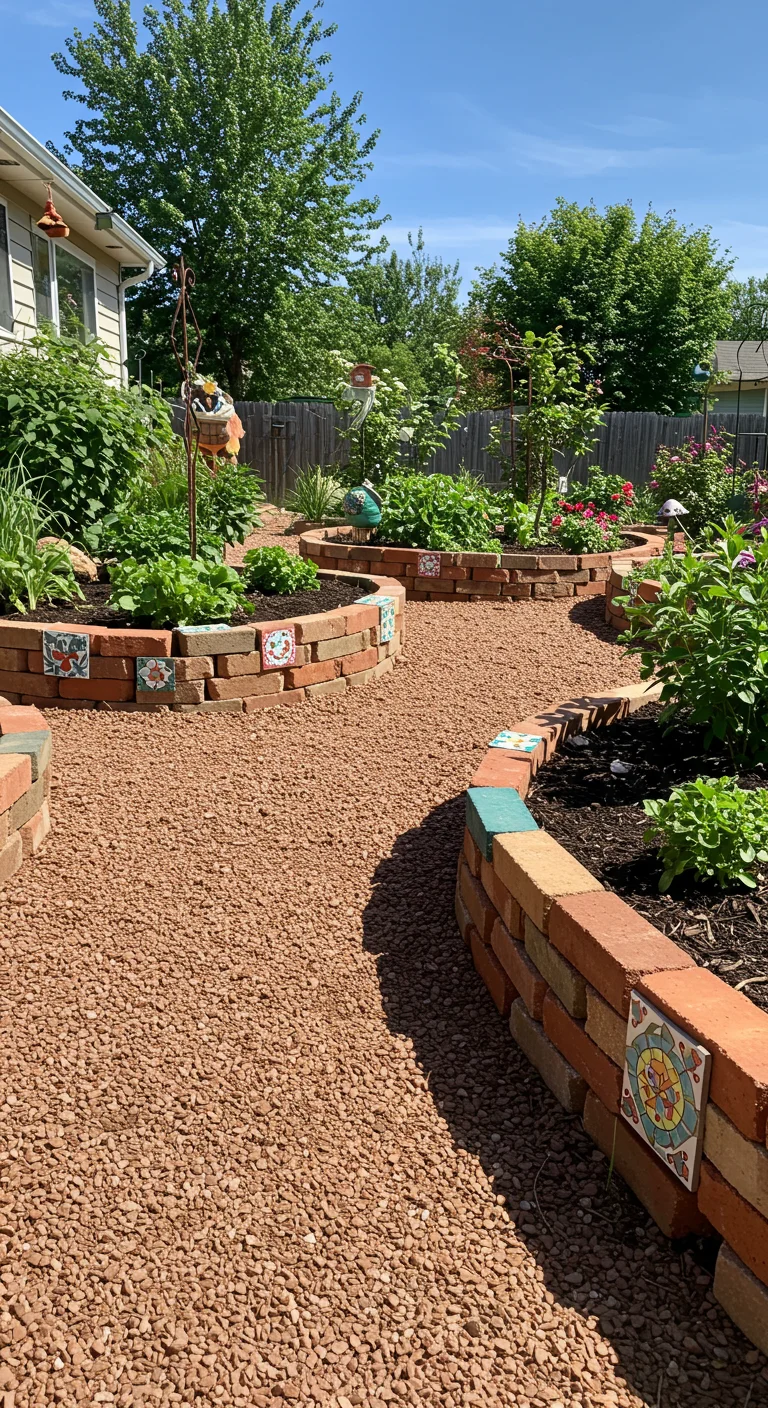
Artistic edging can enhance the visual appeal of your raised bed garden while providing practical benefits such as weed suppression and soil retention. Consider using materials like natural stone, decorative bricks, or reclaimed wood to create unique borders that complement your landscape. You can also incorporate whimsical elements such as painted garden stones, mosaic tiles, or even wrought iron fencing to add character. When designing your decorative borders, ensure they are not only aesthetically pleasing but also functional, allowing for easy access to the plants and integrating well with the overall garden layout. By blending beauty with utility, you can transform your raised beds into stunning focal points that invite admiration and inspire creativity in your gardening endeavors.
24. Pollinator Paradise: Raised Beds for Bees and Butterflies
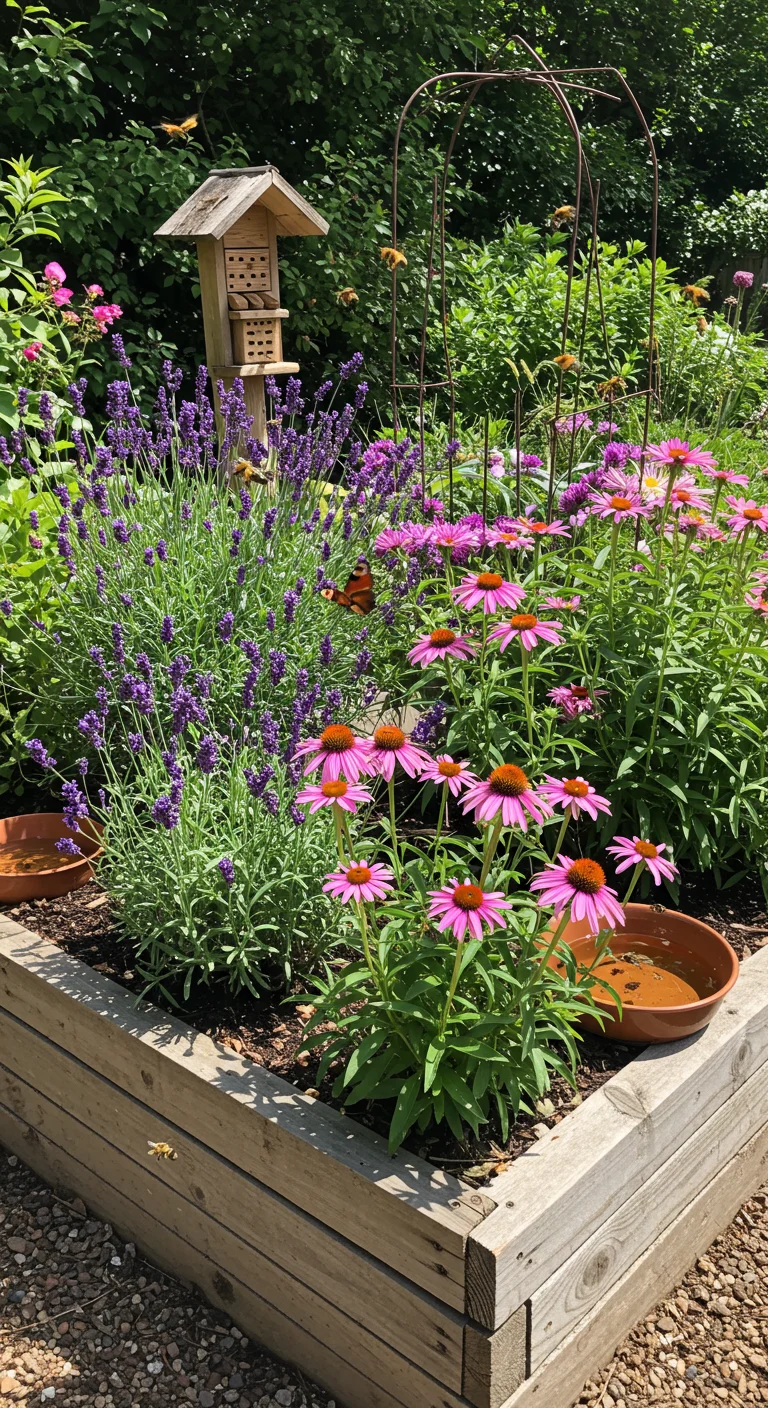
Creating a ‘Pollinator Paradise’ with raised beds is an excellent way to attract bees and butterflies to your garden while enhancing biodiversity. Start by selecting a sunny location, as most pollinators thrive in bright areas. Fill your raised beds with a mix of nectar-rich flowers such as lavender, coneflowers, and bee balm, which bloom at different times to provide a continuous food source. Incorporate native plants, as they are particularly appealing to local pollinators. To further entice these beneficial insects, consider adding water sources, like shallow dishes with pebbles, and shelter options, such as small brush piles or bee hotels. This approach not only beautifies your garden but also supports crucial pollinator populations in your area, making it a win-win for both nature and your gardening efforts.
25. Adaptive Gardening: Raised Beds for All Abilities
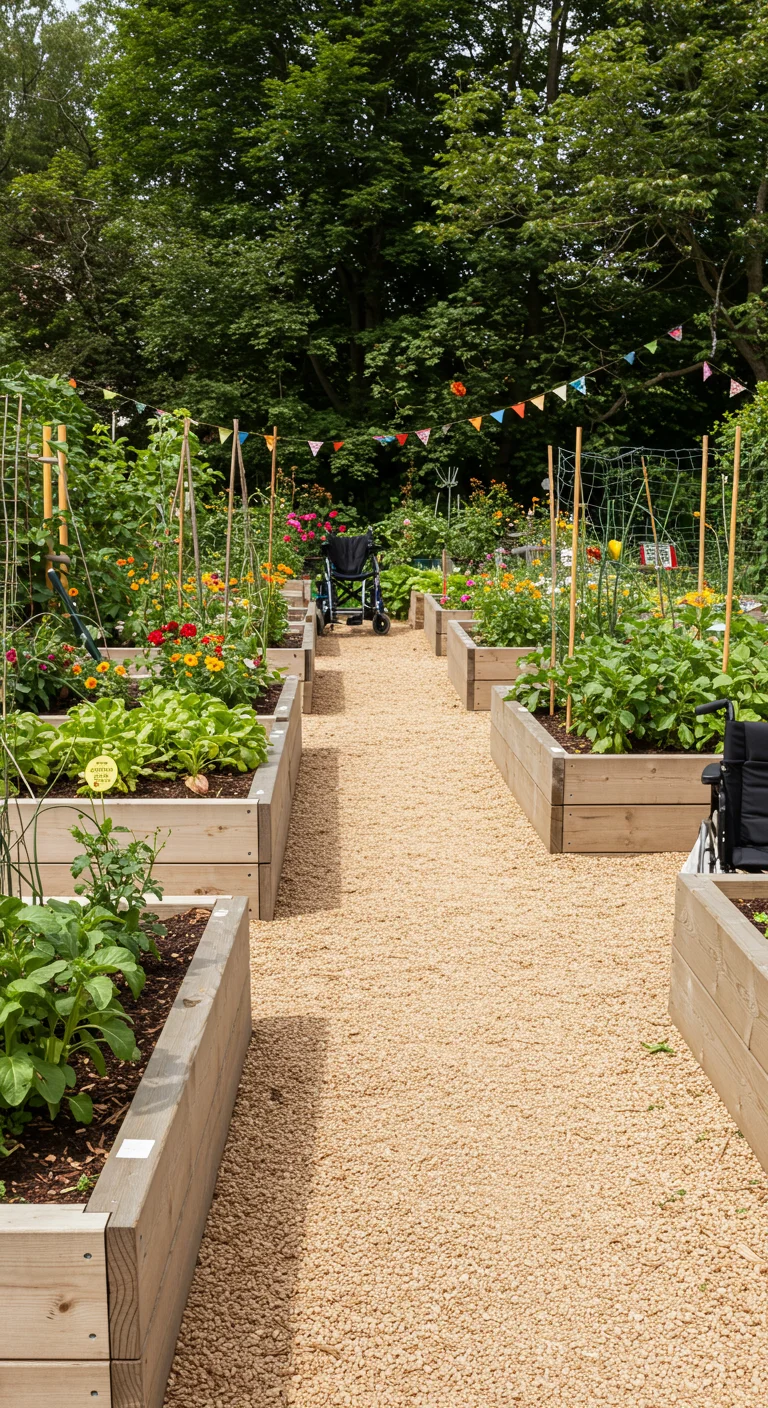
Adaptive gardening using raised beds is an excellent way to create an inclusive gardening experience for individuals of all abilities. By elevating the garden beds to a comfortable height, those who use wheelchairs or have limited mobility can easily reach the soil and plants without straining. Incorporating wide pathways and raised edges can enhance accessibility and safety, while also allowing caregivers to assist more efficiently. Additionally, consider using lightweight materials and modular designs that can be rearranged as needed. Incorporating features like removable panels or adjustable heights can also cater to diverse needs, ensuring that everyone can enjoy the therapeutic benefits of gardening. With thoughtful design, raised beds can transform any space into a welcoming garden for all.
26. Seasonal Splendor: Rotating Crops in Raised Beds
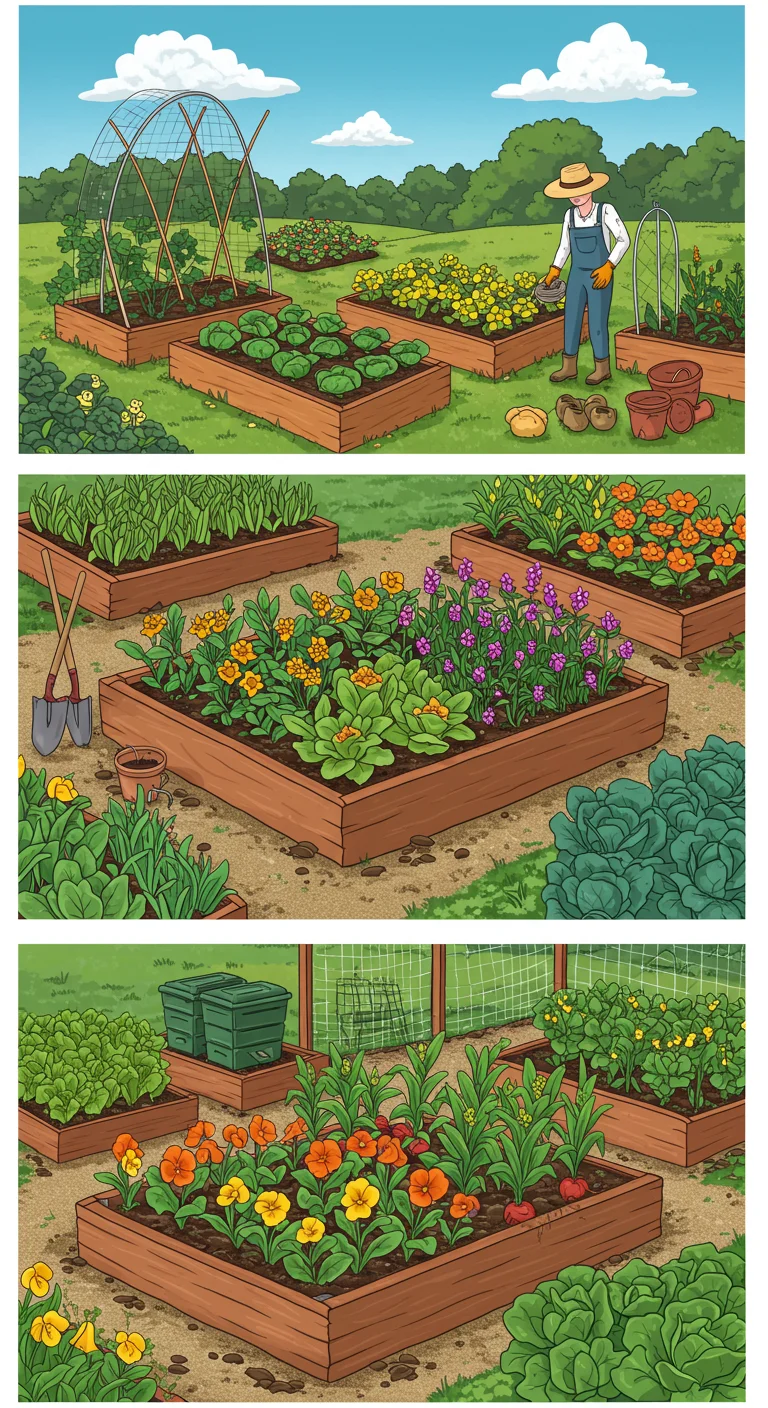
Seasonal splendor in raised beds can be achieved through a practice known as rotating crops. This gardening technique involves changing the types of plants grown in each bed from season to season, which helps to maximize yield, maintain soil health, and reduce pest and disease buildup. For example, in spring, you might plant fast-growing greens like spinach or lettuce, followed by nutrient-rich legumes in summer, and finally root vegetables in the fall. This rotation not only ensures a diverse harvest throughout the year but also promotes a balanced ecosystem within your garden. Additionally, incorporating cover crops during off-seasons can enrich the soil and prevent erosion, making raised beds an efficient and sustainable gardening option.
27. Functional Features: Built-In Irrigation in Raised Beds

Incorporating built-in irrigation systems into your raised bed garden can significantly enhance plant health and reduce maintenance efforts. Drip irrigation is an excellent option, delivering water directly to the plant roots, minimizing evaporation and runoff. You can install a simple network of drip tubing connected to a timer, ensuring your plants receive consistent moisture even during hot summer days. Consider using a soaker hose system for an easy-to-install, low-pressure option that evenly distributes water across the bed. To optimize the efficiency of your irrigation, layer a moisture-retaining mulch on top of the soil, which helps conserve water and suppress weeds. This integration not only promotes healthy growth but also ensures that your garden remains vibrant with minimal effort, making your gardening experience more enjoyable and productive.
28. Creative Combinations: Mixing Materials for Unique Designs
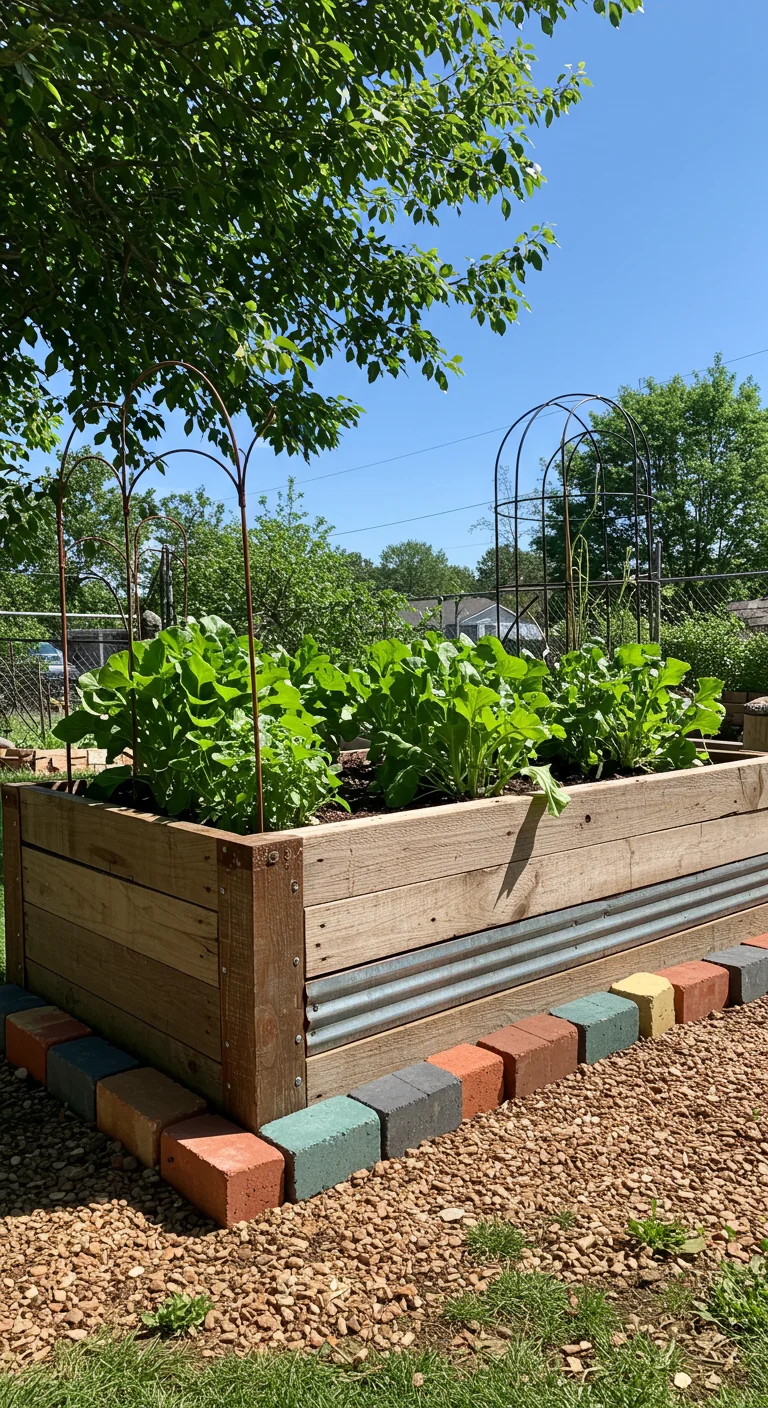
Creative combinations of materials can elevate your DIY raised bed garden designs, making them not only functional but also visually appealing. Consider mixing wood, stone, and metal to create unique textures and contrasts; for instance, use reclaimed wood for the frame paired with metal corners for added durability and a modern touch. Another idea is to incorporate bricks or stones as a base layer or decorative border, which can enhance drainage while adding rustic charm. Additionally, experimenting with different colors of paints or stains on wooden beds can bring a vibrant flair to your garden. Remember to choose materials that are safe for growing food, ensuring a healthy and sustainable environment for your plants.

